The, four elements of compensation are combined into hundreds of different plans, each more, or less unique. But if we disregard the “fringe benefit” and “expense reimbursement” elements:-as is entirely reasonable, since they are never used alone-there are only three basic types of compensation plans: straight salary, straight commission, and a combination of salary and variable elements.
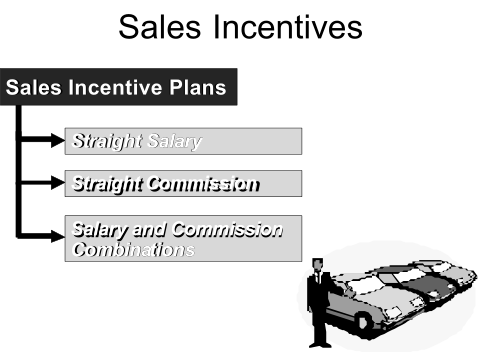
Straight-Salary Plan
The straight salary is the simplest compensation plan. Under it, salespersons receive fixed sums are regular intervals (usually each week or month but sometimes every two weeks), representing total payments for their services. The straight salary was once the most popular sales compensation plan, but it has been declining in importance. Such plans are more common among industrial-goods companies than among consumer-goods companies. Firms that formerly used the straight salary have tended to combine a basic salary with a variable element-that is, they have switched to combination plans.
In spite of the trend away from its use, sometimes the straight- salary plan is appropriate. It is the logical compensation plan when the selling job requires extensive missionary or educational work, when salespeople service the product or give technical and engineering advice to prospects or users, or when salespeople do considerable sales promotion work. If no selling tasks bulk large in the salesperson’s total time expenditure, the straight-salary plan is worthy of serious consideration.
Straight-salary plans are commonly used for compensating salespeople heavily engaged in trade selling. These jobs, in which selling amounts to mere order taking, abound in the wholesale and manufacturing fields, where consumer necessities are distributed directly to retailers Frequently, too, the straight- salary method is used for paying driver-salespersons selling liquor and beverages, milk and bread, and similarly distributed products.
From management’s standpoint, the straight-salary plan has important advantages. It provides strong financial control over sales personnel, and management can direct their activities along the most productive lines. Component tasks making up salespersons’ jobs can be recast with minimum opposition from those affected, so there is flexibility in adjusting field sales work to changed selling situations. If sales personnel prepare detailed reports, follow up leads, or perform other time- consuming tasks, they cooperate more fully if paid straight salaries rather than commissions. Straight-salary plans are economical to administer, because of their basic simplicity, and compared with straight-commission plans, accounting costs are lower.
The main attraction of the straight-salary plan for sales personnel is that stability of income provides freedom from financial uncertainties inherent in other plans. In addition, sales personnel are relieved of much of the burden of planning their own activities (the practice of providing detailed instruction, for example, on routing and scheduling, generally goes along with the straight salary plan). And, because of its basic simplicity, sales personnel have no difficulty in understanding straight- salary plans. The straight-salary plan, however, has weaknesses. Since there are no direct monetary incentives, many salespeople do only an average rather than an outstanding job. They pass up opportunities for increased business, until management becomes aware of them and orders the required actions. Unless the plan is skillfully administered, there is a tendency to under compensate productive salespeople and to overcompensate poor performers. However, many of the straight-salary plan’s weaknesses are minimized through good administration.
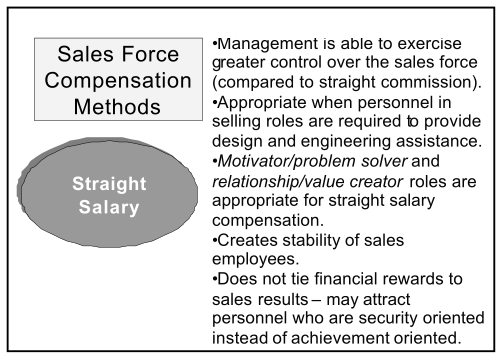
In administering a straight-salary plan, individual sales personnel are paid, insofar as possible, according to their relative performance.
All sales personnel need rating not only on their achievement of sales and cost goals but on their performance of each assigned duty. The total evaluation of an individual is a composite of the several ratings, weighted according to relative importance. Persons rated as average are paid average salaries. Salaries of below-average and above-average sales personnel are scaled to reflect the extent to which their performances vary from the average. Each individual’s performance is regularly reviewed and upward adjustments made for those showing improvements, and downward adjustments made for those with deteriorating performances.
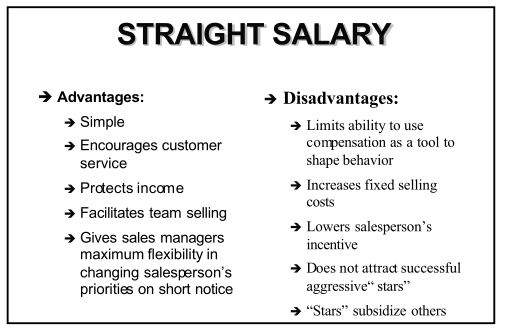
Straight-Commission Plan
The theory supporting the straight-commission plan is that individual sales personnel should be paid according to productivity. The assumption underlying straight-commission plans is that sales volume is the best productivity measure and can, therefore, be used as the sole measure. This is a questionable assumption.
The straight-commission plan, in its purest form is almost as simple as the straight-salary plan, but many commission systems develop into complex arrangements. Straight commission plans fall in to one of two broad classifications:
- Straight commission with sales personal paying their own expenses Advantage may or may not be made against earned commissions.
- Straight commission with the company paying expenses, with or without advances against earned commissions.
There is a general away from the straight –commission plan, and today no more than 6 or 7 percent of all companies use such plans. The straight commission plan is used in situations where no selling duties are relatively unimportant and management emphasizes order getting. Straight–commission plans are common in clothing, textile, and shoe industries and in drug and hardware wholesaling. Firms selling intangibles, such as insurance and investment securities, and manufacturers of furniture, office equipment, and business machines also are frequent users of straight –commission plans.
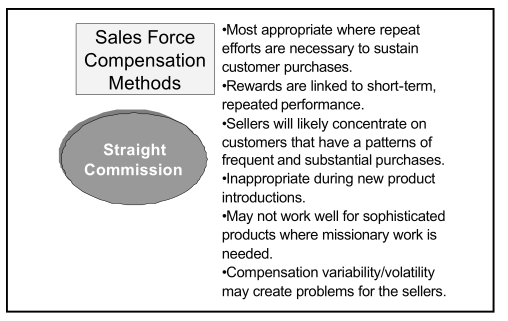
The straight-commission plan has several advantages. The greatest is that it provides maximum direct monetary incentive for the sales person to strive for high-level volume. The star salesperson is paid more than he or she would be under most salary plans. And low producers are not likely to be overcompensated. Straight –commission plans, in addition provide a means for fast control –all direct selling expenses , except for traveling and miscellaneous expenses(which are reimbursable in some plans),fluctuate directly with sales volume changes and sales compensation becomes virtually an all variable expanse. The straight commission plan also is characterized by great flexibility- by revising commissions’ rates applying to different products, for instance it is possible to stimulate sales personnel to emphasize those with the highest gross margins.
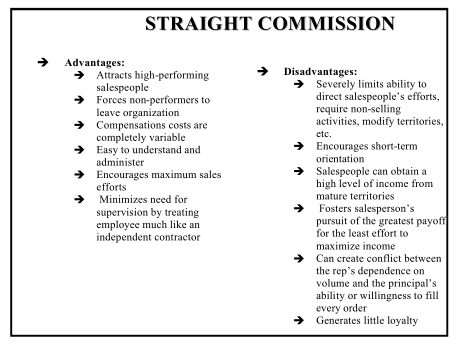
However the straight – commission method has weaknesses provides little financial control over sales people’s activities, a weakness further compounded when they pay their own expenses. Salespersons on straight commission often feel that they are discharging their own expenses. salespersons on straight commission often feel that they are discharging their full responsibilities by continuing to send in customers’ orders .They are careless about transmitting reports, neglect to follow up leads, resist reduction in the size of sales territories, consider individual accounts private property, shade prices to make sales, and may use high-pressure tactics with consequent loss of customer goodwill. Moreover, unless differential commission rates are used, sales personnel push the easiest-to-sell low margin items and neglect harder –to sell high –margin items. Finally, some salespersons’ efficiency may decline because of income uncertainties. If a sales force has many financially worried salespeople; management may have to invest consider- able time, effort, and money to buoy up their spirits.
Determining commission base: One important aspect of designing a straight commission system is to select the base on which to pay commission. Company selling policies and problems strongly influence selection of the base. If obtaining volume is the main concern, then total sales is the base. If sales personnel make collections on sales, commissions are based on collections. If a firm has excessive order cancellations, commissions can be based upon shipments, billings, or payments. To control price cutting by sales personnel, some companies base commissions on gross margins. Other companies use net profits as the base, seeking simultaneously to control price cutting, selling expense, and net profit.

